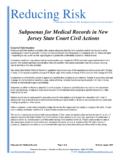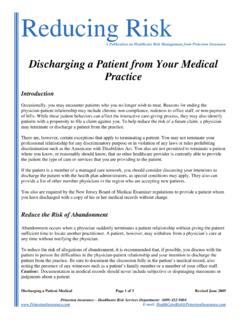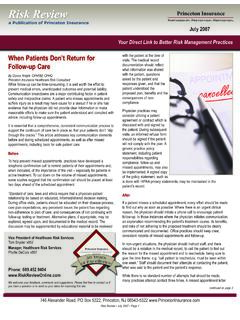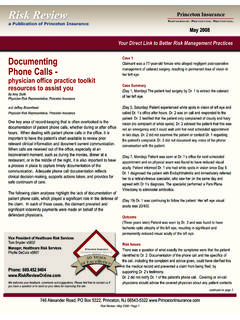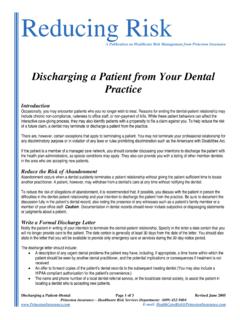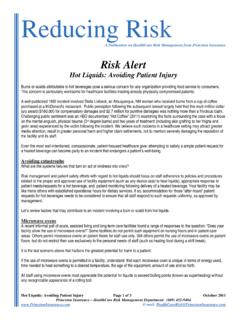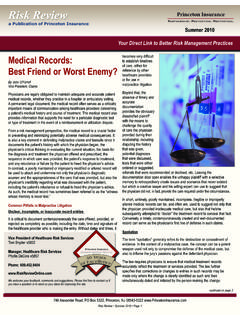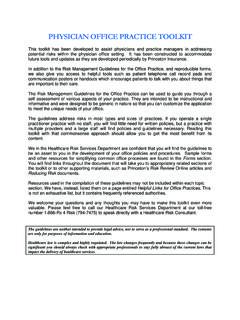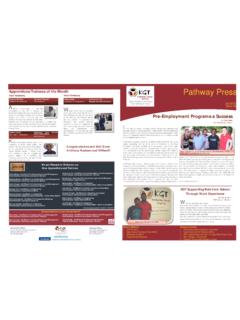Transcription of Introduction Handling Missed Appointments
1 Reducing Risk A Publication on Healthcare Risk Management from Princeton Insurance When Patients Don t Return for Follow-up Care Page 1 of 4 july 2008 Princeton Insurance Healthcare Risk Services Department: (609) 452-9404 E-mail: When Patients Don t Return for Follow-up Care Introduction Communication breakdowns are a major contributing factor in patient safety and malpractice claims. A patient who misses Appointments and suffers an injury as a result may have cause for a lawsuit if he or she has evidence that the physician did not provide clear information or make reasonable efforts to make sure the patient understood and complied with advice, including follow-up Appointments .
2 While follow-up can be time-consuming, it is well worth the effort to prevent medical errors, unanticipated outcomes and potential liability. Handling Missed Appointments To help prevent Missed Appointments , practices have developed a telephone confirmation call to remind patients of their Appointments and, when indicated, of the importance of the visit especially for patients in active treatment. To cut down on the volume of Missed Appointments , some studies suggest that the confirmation call should be placed at least two days ahead of the scheduled appointment. Standard of care, laws and ethics require that a physician-patient relationship be based on educated, informed/shared decision making.
3 During office visits, patients should be educated on their disease process, care plan expectation, any perceived issues the patient has regarding non-adherence to plan of care, and consequences of not continuing with follow-up testing or treatment. Alternative plans, if appropriate, may be explored, agreed upon, and documented in the medical record. The discussion may be supplemented by educational material to be reviewed with the patient at the time of visits. The medical record documentation should reflect what information was shared with the patient, questions asked by the patient and responses given, and that the patient understood the proposed plan, benefits and the consequences of non-compliance.
4 Physician practices may consider utilizing a patient agreement or contract which is discussed with and signed by the patient. During subsequent visits an informed refusal form should be signed if the patient will not comply with the plan. A generic practice policy statement including patient responsibilities regarding compliance, follow-up and Missed Appointments may also be implemented. A signed copy of the policy statement, such as is done with HIPAA privacy statements, may be maintained in the patient s record. If a patient misses a scheduled appointment, every effort should be made to find out why as soon as possible.
5 When there is an urgent clinical reason, the physician should initiate a phone call to encourage patient follow-up. In those instances where the physician initiates communication, an explanation recommending the patient s treatment course, its benefits, and risks of not adhering to the proposed treatment should be clearly communicated and documented. Office practices should keep clear, consistent records of Missed Appointments and follow up. In non-urgent situations, the physician should instruct staff, and there should be a notation in the medical record, to call the patient to find out the reason for the Missed appointment and to reschedule, being sure to give the time frame.
6 ( call patient to reschedule, must be seen within one week ). Staff should document their attempts at contacting the patient, what was said to the patient and the patient s response. While there is no standard number of attempts that should be made, many practices attempt contact three times. A Missed appointment letter should also be sent. If patients repeatedly ( three Missed Appointments ) do not return to the office, a letter urging patients to follow-up should be sent. The non-adherence letter gives such patients one last chance to schedule an appointment before assuming that the patient has terminated the relationship.
7 If patients still do not return to the office a formal Reducing Risk When Patients Don t Return for Follow-up Care Page 2 of 4 july 2008 discharge from the practice may be in order. Evidence of patient receipt via certified mail of the correspondence should be retained in the patient s record. The Missed appointment, non-adherence and discharge letters should state the patient s disease and consequences of not continuing medical/surgical care. If the patient has a condition that requires specific care, the letter should state the care and the consequences of not receiving the care. If the patient has a condition that needs regular follow-up, state the frequency and urgency of the follow-up, and state the consequences of not obtaining the follow-up at the recommended time.
8 All letters should be in clear, reader-friendly language at a fourth grade reading level in order to be understandable and in compliance with limited-English proficiency guidelines. A tracking process, either through a paper log book or electronic medical record system, provides a comprehensive, consistent process for monitoring of patients. This can be incorporated into the existing tracking method for routine screenings, consultations and diagnostic tests. A tracking log enables the practice to document that either follow-up was completed, informed refusal has been signed or that reasonable attempts to contact the patient have been exercised.
9 The practice may also track Missed /cancelled Appointments for specific diagnosis or conditions which the physician determines crucial for patient follow-up. Such circumstances in a surgical office practice may include routine post-operative surgery follow-up. In other practice settings these would include routine screenings for breast, prostate, and cervical cancer screenings, pediatric immunizations, or diabetes and hypertension monitoring. Summary Inadequate physician-patient communication is a primary contributory factor in patient safety and professional liability. Follow-up is a crucial and challenging aspect of the care continuum.
10 Informed/shared decision making, communication and documentation are essential elements of a comprehensive, consistent process. The informed/shared decision-making process between physician and patients is important to ensure the patient understands their disease, plan of care and responsibilities. Communication with the patient before and during scheduled Appointments , as well as after Missed Appointments is key to preventing medical errors, unanticipated outcomes and potential liability. The Princeton Insurance Physician Office Practice Tool Kit, which is available to Princeton Insurance insureds, contains several guidelines and sample forms, including Office Visit Follow-up Instructions, Follow-up Systems & Appointment Log, Informed Refusal and Discharging a Patient from Your Practice guidelines & letter.
